Describing 58-facet Round Brilliant-Cut Diamonds at
GIA
December 20, 2013
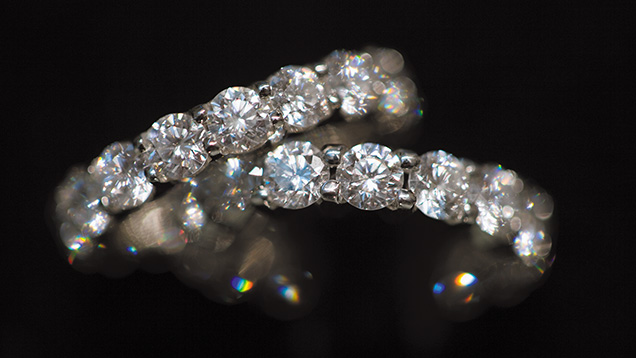
Introduction
Most consumers in today’s marketplace choose round brilliant-cut diamonds fashioned to meet modern concepts of beauty. These sparkling gems represent the collective talents of generations of skilled cutters over more than six centuries.As diamond cuts evolved into today’s 57- or 58-facet round brilliants, styles progressed through many stages. By 1750, when the brilliant cut had developed into a style with a circular face-up outline, it had passed through many variations in facet size and proportions. These included table size, crown height, length of the lower half facets, total depth, and culet size.
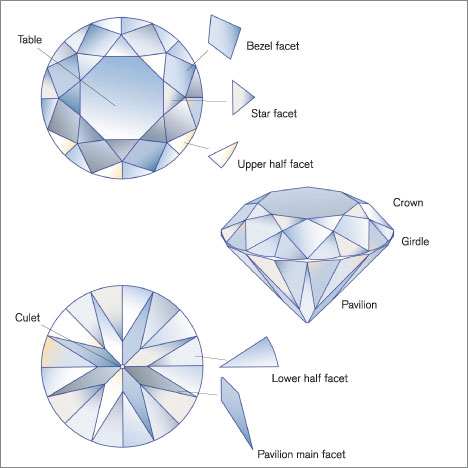
This illustration shows the names and arrangement of the facets of a standard round
brilliant-cut. Illustration by Peter Johnston, © GIA
This progression has resulted in diamonds from different periods having quite distinct appearances. Over time, table facets have become larger, culets smaller, and star facets and lower half facets longer. If you rock or tilt one of the older-style gems, you’ll see a different face-up pattern of light and dark than you would with a contemporary brilliant-cut.brilliant-cut. Illustration by Peter Johnston, © GIA
Transition to Modern Brilliants
This video shows three styles of brilliants with round face-up outlines. From left to right, they are an old European cut, in place by 1750; a “transitional” brilliant from around 1880; and a modern round brilliant, in place since the 1950s. The transitional cut is labeled “circular brilliant” in the video; this is the same term now used by GIA on grading reports.The three animations show how cutting styles developed over time, causing the different face-up patterns associated with each proportion set. Animations by Al Gilbertson, © GIA
Many beautiful older diamonds present a conundrum for diamond-grading laboratories—including GIA's—because their proportions diverge from contemporary conventions. This makes it difficult to judge them against today’s aesthetic. In spite of this, there is a market for their antique beauty. In fact, some consumers cherish their different interplay with light.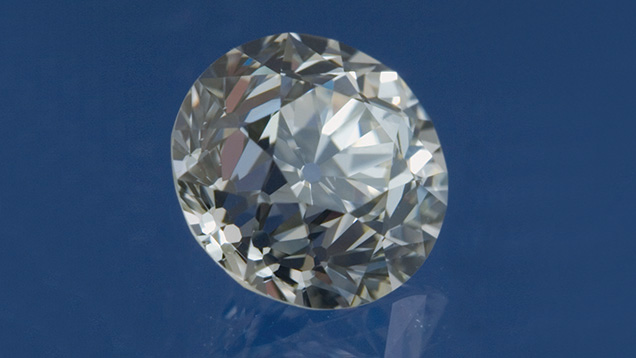
Compared to a modern round brilliant cut, this older-style 1.07-ct. brilliant has a much smaller table (38.5 percent), a higher crown, shorter lower halves, and a much larger culet. Digitally modified image by Al Gilbertson, © GIA, courtesy of Michael Goldstein
Compared to a modern brilliant, older gems typically show larger face-up patterns of light and dark—what might be described as a “checkerboard” or “blocky” pattern. A modern brilliant can display a tighter mosaic of light and dark that might be described as “splintery” by those who prefer older cutting styles.Many older round brilliants were cut between the 1870s and the 1940s. Because some served as transitions between older and more-modern styles, some trade professionals call them “transitional cuts.”
Recent high prices for precious metals have caused many pieces containing older-style diamonds to be broken up, releasing more of these beautiful gems into the market and increasing appreciation for their historic nature.
This article explains GIA’s approach to describing these beautiful older-style brilliant-cut diamonds.
The GIA Cut-Grading System for Unmodified Brilliant-Cut Diamonds
In 2005, GIA introduced a cut-grading system for unmodified round brilliant cut diamonds. The name “unmodified round brilliant” was applied to a symmetrical round cut with a regular array of 58 facets, cut to modern standards. The system was the culmination of years of research that included the results of preference testing among a wide variety of groups, including trade professionals and consumers.GIA designed the system to assess the design quality and craftsmanship of diamonds cut in the standard round brilliant style when compared to modern preferences. The system’s grades are based on modern-day conventions and assess the proportions that yield the best combination of brightness, fire, scintillation, and pattern. There are five grades: Excellent, Very Good, Good, Fair, and Poor.
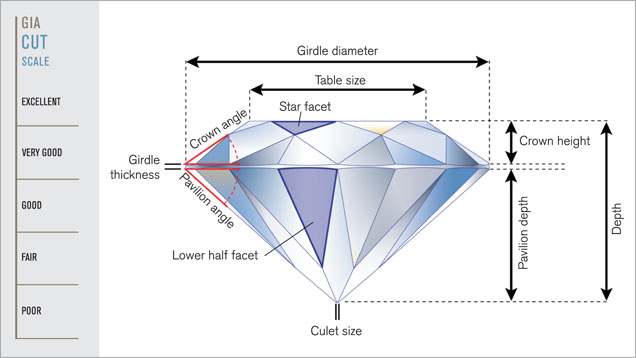
GIA’s cut scale for unmodified round brilliant-cut diamonds includes five grades. Today, the majority of the round brilliant cuts graded by GIA fit into the top two grades. This illustration shows some of the key proportion parameters that impact a round brilliant-cut diamond’s appearance. Illustration by Peter Johnston, © GIA
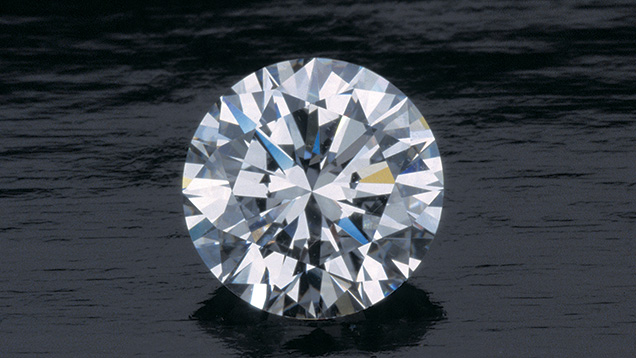
GIA’s cut-grading system was designed to assess the beauty and craftsmanship of modern round brilliant-cut diamonds like this 2.78-ct. gem. Photo by Robert Weldon, © GIA
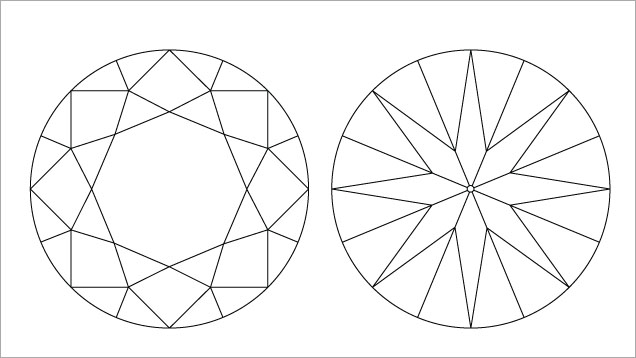
This illustration shows the facet arrangement of a modern round brilliant. © GIA
The Old European Cut
Historically, GIA has described unmodified round brilliant-cut diamonds as either “round brilliant” or “old European.”The old European cut was an early evolutionary stage in the progression toward the modern round brilliant. In general, trade professionals characterize old European cuts as having small table facets, heavy crowns, and overall “deep” or “steep” proportions.
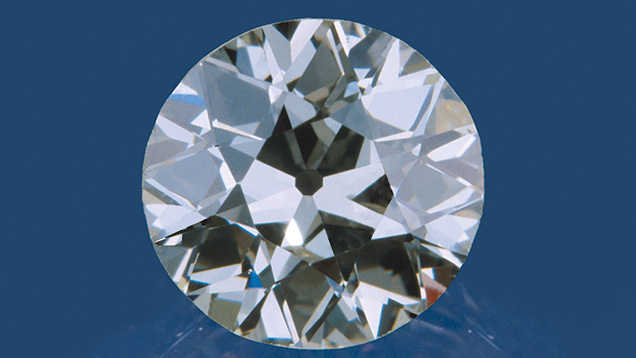
This diamond has a small table, large culet, and short lower-half facets. These are typical of diamonds from the late 1800s. This style kept evolving until the 1950s, when it would have a larger table, longer lower-half facets, and a smaller culet. Photo by Al Gilbertson, © GIA
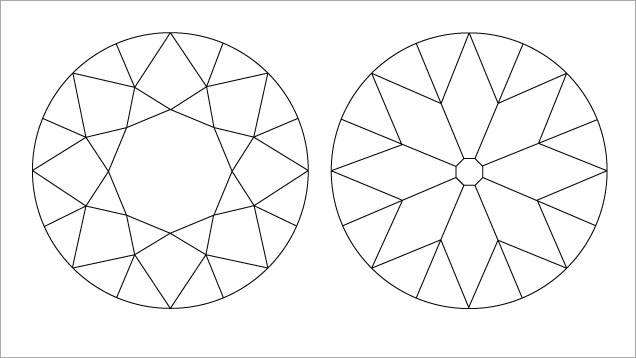
This illustration shows the facet arrangement of an old European brilliant cut. © GIA
Initially, GIA allowed only one exception—the old European cut—into its cut-grading system. This accommodated the distinctive proportions of diamonds cut in this classic style. Its appearance is associated with a time that predates expectations of conformity with the appearance of the modern-day round brilliant. As a result, GIA does not apply a cut grade to diamonds cut in the old European style.GIA identifies classic old European cuts using these criteria:
- Table size: less than or equal to 53 percent
- Crown angle: greater than or equal to 40 degrees
- Lower half facet length: less than or equal to 60 percent
- Culet size: slightly large or larger
In practice, if a diamond meets three out of the four criteria, it will still receive the old European cut designation on a GIA grading report. The report simply provides the gem’s measurements and grades for color and clarity. This is because GIA recognizes that, centuries ago, cutters working with natural material tried to retain as much of the original weight of the crystal as possible, so proportions often differed wildly.
Styles between Old European and Modern Round Brilliant Cuts
The old European cut was by no means the last step in the journey toward fully modern round brilliants. As cutters continued to experiment with proportions, there were many incremental steps between the old European style and the modern round brilliant.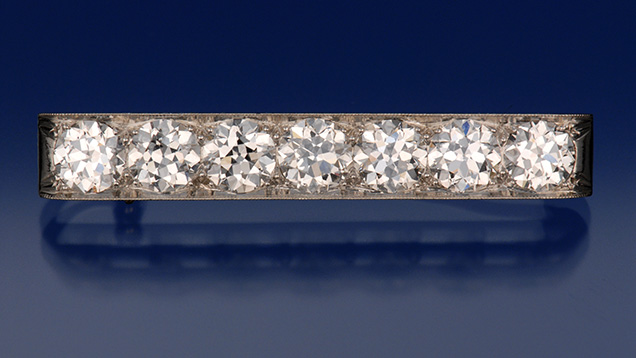
This Tiffany & Co. brooch contains seven diamonds with an approximate total weight of five carats. They are very well-matched, “transitional” round brilliants, with the smaller table facets (52 to 54 percent); short lower half facets; and culet sizes typical of cuts created during the period from 1870 to 1950. Photo by Robert Weldon, © GIA
With growing interest in the allure of these historic cutting styles, GIA receives many diamonds in styles close to—but not quite meeting—old European criteria. Expectations for them are quite different from contemporary expectations for a modern round brilliant. This drove GIA’s decision to add a new description to address diamonds that fall outside the existing categories of both old European and modern round brilliant.The Circular Brilliant Designation
GIA sought to address older-style diamonds that aren’t strictly Old European, but also aren’t cut to meet modern standards. Previously, GIA graders had to decide whether to call a stone a round brilliant and grade it according to contemporary standards, or to call it an old European cut and simply record color and clarity without a cut grade.To establish judgment criteria and help define these diamonds, GIA met with members of the trade and borrowed many examples of transitional cuts from dealers. The goals were to:
- Create a new description for older-style rounds that reflects their historic cutting approach
- Prevent cut grades from being assigned to diamonds that were never fashioned to modern round-brilliant parameters
- Prevent poorly cut modern round brilliants from passing through the GIA cut-grading system without receiving grades
In general, the diamonds resembled the old European cut style, but they didn’t meet GIA’s required proportion parameters for that description. Although culets were often slightly large or larger, a number of examples had medium culets. Table facet sizes ranged from 43 to 62 percent, which made this parameter difficult to use as a standard for a new category. The two characteristics that most of the stones shared were shorter lower half and shorter star facets.
Following this review, GIA decided to introduce a new description for 58-facet round brilliants. The requirements for a stone to fall into this new category are:
- Lower half length: less than or equal to 65 percent
- Star length: less than or equal to 50 percent
- Culet size: medium or larger
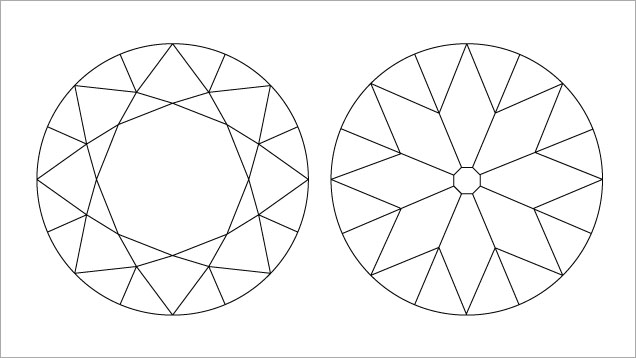
This illustration shows the facet arrangement of a circular brilliant. © GIA
Prior to the new circular brilliant designation, GIA graded any diamond outside these parameters as though it was a modern brilliant. As with the old European cut, reports for diamonds that fall into this new category aren’t assigned a cut grade.These diamonds evoke a bygone romantic era. Their shorter lower halves contribute to a different pattern of light and dark than that seen in an equivalent-size modern round brilliant cut, and that some consumers cherish. By establishing the circular brilliant term and the parameters that help define it, GIA has recognized the unique nature of these antique diamonds.
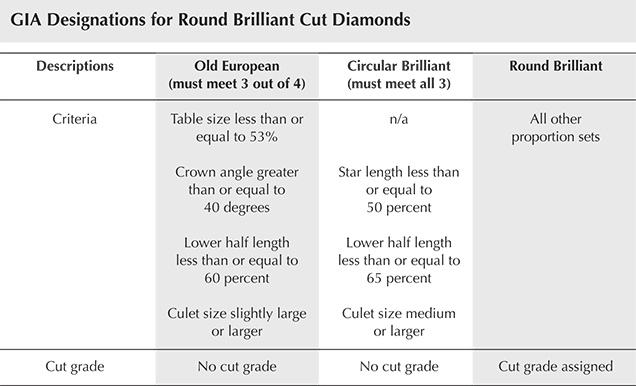
About the Author
Duncan Pay is editor-in-chief of Gems & Gemology at GIA content development in Carlsbad, California.
Acknowledgments
The author would like to thank Al Gilbertson, the project manager for cut research at GIA Carlsbad, for reviewing this article and providing the animations of the various brilliant cuts, and Nancy Powers, digital media specialist at GIA content development in Carlsbad, California for editing the animations into a video.



